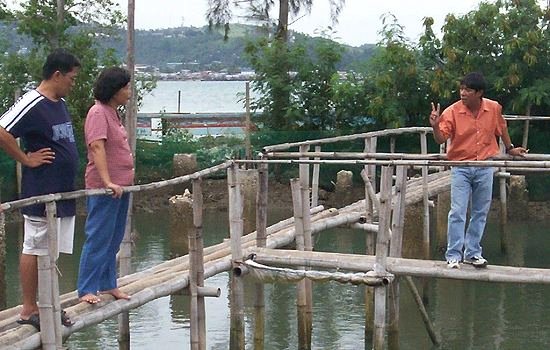Regional Fisheries
Training Center - showcasing polyculture
By NINFA B. QUIRANTE (PIA
Samar)
August 27, 2007
CATBALOGAN CITY,
Samar – The Regional Fisheries Training Center at the Bureau of
Fisheries and Aquatic Resources (BFAR) housed at the Samar State
University (SSU) - College of Fisheries Campus in Barangay Mercedes,
Catbalogan City maintains a polyculture pond teeming with bangus,
tilapia and mudcrabs.
Norberto Berida,
Center Director with Clutilde Amparado showed PIA the Brackish
WaterAquaCulture Development Project inside the SSU Campus.
Polyculture, said the
fishery experts could be equated with multi-cropping that is done in
farm agriculture.
Crisscrossed by bamboo
bridges, the farm shored up in a 3,000 square meter pond is home to
some 2,500 pieces of mudcrabs (Scylla serrata), 5,000 bangus (Chanos
chanos) and 3,000 tilapia (saline).
The bamboo bridges
facilitate feeding and harvesting.
For fishponds to
flourish, every care is done to ensure that they have some 94%
survival rate as their case, said Berida. They last harvested in April
2007.
Based from the BFAR
website, it talks of polyculture as a way to intensify fish culture
without an input of expensive feed. In this way the natural food
produced in the culture environment is utilized to a greater extent
through compatible or complementary feeding habits of fish which do
not compete with each other.
Yields obtained by
polyculture are usually much higher than those obtained by
monoculture, especially if the right species have been chosen, it
further explained.
Mudcrabs
Mudcrabs, said these
experts, have to move freely and establish their own homes so that a
certain density has to be observed. Each crab should have some 1.5
meters to consider its home for ‘wars’ to be avoided. Like human
beings, crabs too should have their ‘home sweet home’ with no
intruders please.
A monthly sampling for
weight check like human infants, have to be done. Not only weight,
body length and even the average weight and length have to be recorded
for analysis. As crablets, they weighed an average of 18 grams then,
in the latest weighing sample done in July yet they have grown some
6,685 grams.
This is maybe the
reason why fishpond owners do not like to follow the scientific way
said Teddy (Clutilde). The maintenance is too tedious. There is a
computation of area, feeds and monthly monitoring of growth such that
most pond owners ignore – result- they close shop because they lose.
“BFAR always emphasize
scientific method,” said Berida. BFAR insists they have the expertise
and only waits for those who would tap them.
Bangus
As to the bangus,
Berida said they have harvested most of them and have just retained a
thousand waiting for a deboning training for the womenfolk in the
area.
“The training center
should not only serve as a demonstration farm; it should also have an
impact on the community,” said Berida.
Deboning bangus
could very well come handy to fish processors in this thriving fishery
city in Samar.
While Samar boasts
then of a very rich Maqueda Bay fishing area, studies show that the
tonnage of fish caught has greatly diminished through the years.
Limelight then would
be shifted to cultured fish like bangus.
With this, women who
are jobless could be assisted. Consumers today are so busy they would
rather purchase processed goods for convenience.
Deboned and marinated
bangus could be very handy.
Tilapia
As for tilapia, as it
does not possess many bones like bangus, it just completes the
fish species in the pond.
As gleaned from the
BFAR literature on polyculture, other benefits gained by polyculture
is quite often the ecological conditions in a pond are improved. It
has been found that Tilapia aurea in a polyculture system improves the
oxygen balance by feeding on the detritus which would otherwise
decompose and take up oxygen.
If one were
interested in managing a fishpond through polyculture, Ronnie Berida
and Teddy Amparado are just as accommodating. They just wish that
interested parties follow the scientific method so that the expected
end results will be achieved as what they gain from their BW
Aquaculture Development Project at the SSU- Mercedes Campus down there
in Catbalogan City.
| |
|

BFAR
Regional Training Center Director Ronnie Berida and another
fishery expert Teddy Amparado explain to PIA reporter NB
Quirante "polyculture" right where they practice it.
(Photo
courtesy of Samar Monitor) |